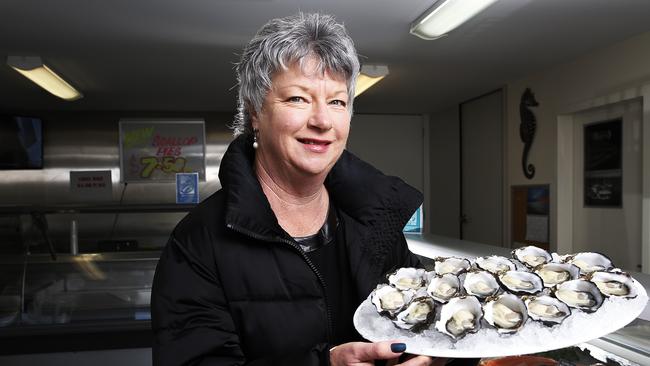Tasmania’s next big trade markets
Tasmanian farmers and businesses are being urged to diversify as coronavirus and rising tensions with China impact trade. Here’s where our next big markets are.
Tasmania
Don't miss out on the headlines from Tasmania. Followed categories will be added to My News.
JAPAN, Malaysia, Singapore and the United States are tipped to be Tasmania’s next top export markets as businesses look to diversify in the wake of the coronavirus pandemic and rising trade tensions with China.
The state’s business community is also eyeing Indonesia, India, Thailand, the Philippines and Vietnam as some of the next big growth markets.
Taiwan, New Zealand, Britain, South Korea, the European Union and Latin America are also part of longer-term plans to grow the state’s trade to $15 billion by 2050.
READ MORE NEWS:
AMBULANCE INVOLVED IN CRASH IN TASMANIA’S NORTH
COLLEGE STUDENTS TO UNDERTAKE MODIFIED CURRICULUM
JOBKEEPER BUNGLE SPARKS HOPE FOR TASSIE BUSINESSES
SATELLITE DEBRIS PUTS ON LIGHT SHOW OVER TASMANIA
Exporters were being urged to look beyond China even before COVID-19 hit but the push has ramped up in the past week after Beijing slapped an 80 per cent import tax on Australian barley and blocked four Australian abattoirs.
“I believe there is a real need to diversify away from China and I have been saying that for over 12 months now,” Tasmanian Chamber of Commerce and Industry’s international trade adviser Sally Chandler said.

While China remains the state’s biggest market, taking $1.2 billion worth of Tasmanian goods in 2019, Ms Chandler flagged Indonesia, Vietnam, Thailand and India as major growth markets to watch.
Indonesia was “very much on the radar” with a free trade deal with Australia starting on July 5, which will axe or lower duties for 99 per cent of Australian goods entering the country.
“Vietnam is another one that is really starting to make an impact and is wanting more global products and services,” Ms Chandler said.
“It has huge manufacturing bases so it’s one to look at.
“Thailand is also in the mix; it’s a big manufacturing country and a lot of our aluminium, tin and zinc go there as base metals for making machinery.”
India was also “really one to watch for the future” with a booming population and massive infrastructure expansion plans.
TCCI will be holding webinars for businesses every fortnight for the next three months with Australian trade officials in Malaysia, Thailand, the Philippines, New Zealand and Vietnam to help companies look at new opportunities.
The state government is also looking at how China, the US, Japan, Malaysia and Singapore will rebound after coronavirus as it draws up Tasmania’s next trade annual action plan.
Trade Minister Jeremy Rockcliff said the next 12-month strategy, to be released later this year, would largely focus on a recovery plan for post COVID-19 trade.

Market diversification and risk management had always been “fundamental considerations” for Tasmania’s trade strategy, he said.
“Even prior to the COVID-19 pandemic, we recognised that the global trading market is volatile due to a range of factors including geopolitics, biosecurity, global supply and demand, and financial fluctuations,” Mr Rockcliff said.
“While China is an important market for many Tasmanian exporters there are other key markets such as beef and cheese into Japan, lamb into the Middle East and onions into Europe.
“Mainland Australia is also a key priority market for Tasmanian exporters and often an important interim market for those progressing from intrastate supply.”
Federal Trade Minister Simon Birmingham will officially begin negotiations with Britain for a post-Brexit free trade deal shortly and is continuing talks with the European Union.

SILVER LINING IN COMPANY’S OYSTER SALES
UNEXPECTED opportunities and new overseas markets are opening up out of the coronavirus pandemic for Tasmanian businesses like Tas Prime Oysters.
The local seafood operator is developing a new line of frozen oysters that can be packaged up and sold in supermarkets, as the costs of shipping products overseas rises during the crisis.
The new product is part of a wave of innovation from Tasmanian businesses, which have had to drastically alter their business strategies during the outbreak.
“I’ve always believed in the theory of when one door closes, another one opens,” manager Jane Kenane said, although she joked coronavirus had been more like the door slamming shut.
The company had previously sold its premium oysters mostly into the wholesale market in Australia, as well as Hong Kong and Japan.
Its usual markets have essentially collapsed for the moment, but others are emerging as new opportunities, including Vietnam and Thailand.
“Hong Kong is the main market at the moment, we’re having great success there,” Ms Kenane said.
“Singapore has also popped up with interest. We’re still negotiating there.”
Vietnam had been a tricky market in the past, but it had potential, she said. “We will try and get in there.”
The closure of local restaurants has also been a hit for the company.
But the setbacks prompted them to bring forward plans to develop a line of frozen oysters with different flavours to sell in supermarkets.
TASMANIA’S TOP EXPORT MARKETS
China:- $1.23 billion
Japan: $310 million
Malaysia: $205.2 million
United States: $203.9 million
Thailand: $196 million
Indonesia: $193.9 million
FISH EXPORTS
China: $89.5 million
Japan: $11.9 million
Vietnam: $10.5 million
Indonesia: $10.3 million
CHEESE EXPORTS
Japan: $52.7 million
Indonesia: $5.6 million
New Zealand: $4.2 million
South Korea: $3.7 million
BEEF EXPORTS
Japan: $87.3 million
China: $15.7 million
Canada: $1.8 million
VEGETABLES
United States: $16.9 million
France: $2.8 million
Canada: $2.6 million
Source: DFAT customs data for 2019


